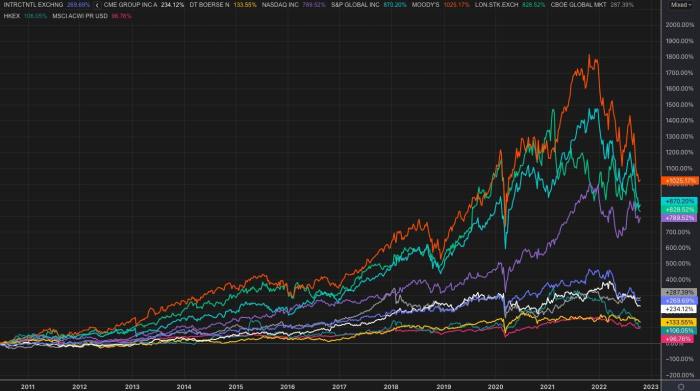Rupak Ghose is the chief operating officer of Galytix, former head of corporate strategy at ICAP/NEX and a former financials research analyst at Credit Suisse.
My first exposure to the world of exchanges was watching Eddie Murphy and Dan Aykroyd corner the frozen orange juice futures market on the floor of the New York Board of Trade. Much has changed since then.
Despite the death of trading pits, at almost every turn the financial market infrastructure sector of exchanges and data providers has thrived. It was an industry golden era.
Until now. Relative valuation multiples have gradually contracted since the financial crisis, and share prices of many companies in the industry have lagged in recent years. Here’s what the majors have done in 2022:
This seems a bit weird, right? The volatile macro backdrop has been beneficial, after all. Bank trading revenues remain robust. Algorithmic trading firms like Citadel Securities and Jane Street are producing monster results. And so too are the commodity giants in Geneva. Is this just mean reversion and maturity, or is Mr. Market telling us that the golden era is now over?
On balance, yes. I can see five big murky clouds on the horizon for the financial market infrastructure sector: fewer regulatory tailwinds; a paucity of scalable newer products; slower capital markets growth; a democratisation of data and a tougher M&A environment.
Let’s start with regulation. Futures exchanges, clearing houses, OTC valuation providers, rating agencies and electronic trading platforms were all able to surf on the wave of new regulatory requirements and economic incentives that came in the wake of the financial crisis. That wave is now breaking. In most products and asset classes — from futurisation to clearing to electronic OTC trading — penetration levels are high.
At the same time, the post-crisis market structure in creaking a little, with mounting liquidity and collateral challenges. Aside from the LME scandal most of the new infrastructure has muddled through, but regulators are unlikely to be offering up any Christmas presents anytime soon.
Second is the lack of scalable new products. What was unique about the last decade of new product growth was that many were natural monopolies, either protected by regulatory barriers or vast network effects, with very high incremental margins. After all, how much marketing or R&D do you need for a product where you have a huge natural advantage from your legacy franchise?
For all the fervour over areas like ESG or crypto, there is no new golden source of data. The moats are shallow. making building a dominant franchise difficult. Just look at the share prices of Coinbase or Robinhood. Yes, there are a few attractive niches, like private asset data. But overall the economics of new products resemble (at least today) more the fight club of interdealer broking than the castle on top of the hill that is a futures exchanges.
Thirdly is a slowdown in capital markets growth. Although banks and consumer deleveraged over the past decade, there was a tsunami of capital markets activity in areas like bond issuance. We are seeing a drought this year, which has hit S&P Global and Moody’s. In contrast, more boring businesses like consumer banking are surging with rising interest rates.
Capital markets have also been a scale game. The bigger are getting bigger, whether in banking, asset management, hedge fund and high-frequency trading. That has meant high internalisation rates, but across the board higher concentration of financial participants means greater buying power for them.
Fourth is the explosion of open-source data and news available free to anyone, rather than being proprietary to traditional data vendors. If anyone thought this was only relevant for a small segment of the market, just look at the crazy weekend when Credit Suisse CDS spreads were trending on social media.
Finally, probably the greatest driver of value creation in the listed financial market infrastructure sector in the last two decades has been M&A. This has allowed firms to expand into fast growing areas and benefit from economies of scale. But there are fewer obvious assets left to buy today.
The banks have now sold all their relevant businesses. Deal multiples continue to be high as private equity has discovered the industry’s attractive economics. And lower valuation multiples and rising cost of debt funding has made deals more expensive.
This is a game changer. M&A was a way for financial market infrastructure groups to generate significant cost savings as matching engines, data centres, platforms and people could be rationalised. (Unlike asset management M&A, the most valuable assets didn’t have legs and couldn’t walk out of the door.) But most companies in the space are now huge, and too much diversification always carries with it the threat of the famous GE conglomerate discount.
Where next for financial market infrastructure groups? There are no magic bullets. New products in adjacent spaces take time to nurture. Deeper strategic partnerships with both large financial institutions and technology disrupters are crucial. Boards of large conglomerate market infrastructure groups shouldn’t forget their “mutual” roots, where customers owned them.








